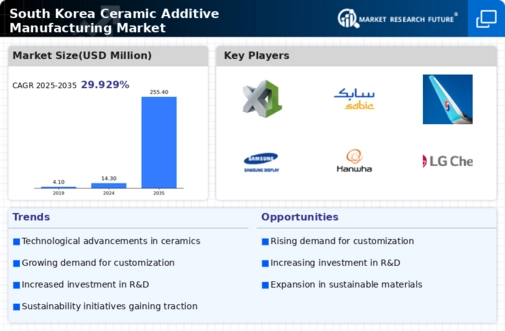The South Korea Ceramic Additive Manufacturing Market has been witnessing significant growth and competitive dynamics as advancements in technology and material science spur innovation in the production of ceramic parts and components. As the demand for customized and complex ceramics increases across various sectors, including electronics, aerospace, and medical, the market is becoming increasingly attractive to both established players and new entrants. Competitive insights reveal a landscape marked by a variety of strategies, ranging from the development of proprietary materials to the adoption of novel manufacturing techniques aimed at improving efficiency and lowering costs.
This environment fosters collaboration, as companies seek partnerships and joint ventures to leverage complementary strengths, while intellectual property protections remain a crucial aspect in maintaining a competitive edge. Dongwoo FineChem, a prominent player in the South Korean Ceramic Additive Manufacturing Market, holds a significant market presence thanks to its robust portfolio of high-performance ceramic materials. The company's strengths lie in its extensive research and development capabilities, enabling it to innovate in the realm of ceramic powders tailored for additive manufacturing applications.
Dongwoo FineChem benefits from well-established relationships with local manufacturers and OEMs, allowing it to respond quickly to market needs and maintain a competitive advantage. Their commitment to quality assurance and continuous improvement also enhances their reputation, ensuring that they meet the high standards demanded by the industries they serve. By focusing on customer-centric solutions and product reliability, Dongwoo FineChem positions itself favorably in a rapidly evolving market. ExOne maintains a strategic foothold in the South Korea Ceramic Additive Manufacturing Market, known for its advanced binder jetting technology which is particularly suited for ceramic part production.
The company offers a diverse array of services, including equipment development and material solutions specifically designed for ceramic applications. ExOne's strengths lie in their innovative approach to manufacturing processes, which allows for the efficient production of complex geometries that traditional methods cannot achieve. Their presence in South Korea is bolstered by partnerships with local businesses and academic institutions, fostering a collaborative environment for technological advancement. Moreover, ExOne's expansion efforts are highlighted through strategic mergers and acquisitions aimed at enhancing their capabilities and broadening their market reach.
This integrated approach underscores ExOne's commitment to driving innovation in the ceramic additive manufacturing sector within the South Korean context.



















Leave a Comment